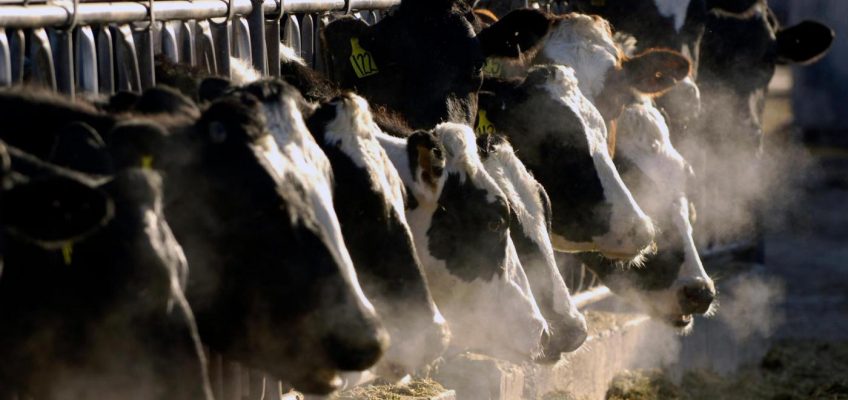Minnesota on Thursday, June 6, reported its first case of H5N1 highly pathogenic avian influenza in a dairy herd in Benton County.
With detections in nearby South Dakota and Iowa dairy herds and a dramatic increase in avian influenza in the state, Minnesota’s State Veterinarian Brian Hoefs knew the likelihood was high.
“We knew it was only a matter of time before this detection would reach our doorstep,” he said in a Board of Animal Health news release. “It’s important for dairy farmers to follow the example of this herd and test sick cows. The more the animal health community can learn about this virus today through testing and research, the better we can equip ourselves to prevent infections tomorrow.”
Over the weekend, the producer noticed clinical signs in a handful of cows; the next day, more than 40 cows had signs of fever. Samples collected from sick cows in the herd on Monday were sent to the University of Minnesota Veterinary Diagnostic Laboratory, where the virus was detected. The USDA’s National Veterinary Services Laboratories confirmed the results Wednesday night.
According to the Centers for Disease Control and Prevention, pasteurized dairy products remain safe to consume.
More than 80 dairy herds have been infected with the virus across 11 states since late March, and three dairy workers have tested positive for the virus.
Idaho, Colorado, South Dakota, Kansas, New Mexico, Texas, Michigan, Ohio, Iowa and North Carolina have also confirmed cases of infected dairy herds.
Dairy cows with avian flu have died or been slaughtered by farmers after not recovering , Reuters reporting found. The U.S. Department of Agriculture said the vast majority of cows recover from the illness.
Dairy farmers should monitor their herds and contact their veterinarian immediately if cows appear sick, according to the Board’s news release. HPAI symptoms in dairy mostly affect late-stage lactating cows and include fever, a drop in milk production, loss of appetite, and changes in manure consistency.
No matter the HPAI status of a herd, biosecurity can reduce the risk of disease spreading onto or off farms:
Consider stopping or delaying any cow movements and test for H5N1 before you move animals.
Milk any sick cows last, after your healthy herd.
Keep feed covered and clean up feed spills immediately.
Provide cows a clean source of water kept secure from wildlife, especially waterfowl.
Talk to your herd veterinarian if you notice any signs of illness in your animals.
Dairy farms are always required to dispose of milk from sick animals to remove it from the milk supply. In addition to disposing of milk from sick cows and isolating them, the Board quarantined the entire herd for 30 days to reduce the risk of disease spread off the farm. After 30 days from the last positive test result, the herd can be retested to be released from quarantine.
The risk to the public from this virus remains low at this time, the Board said. People who work with or have direct contact with infected animals could be at risk of getting sick. The Board is working closely with the Minnesota Department of Health on this response. MDH’s role is to monitor the health of people who have direct contact with infected animals and provide public health information and recommendations.
The CDC recommends people who work with infected or potentially infected animals wear personal protective equipment. More information is available on the CDC’s website . Farmers can request PPE from MDH. Symptoms of avian influenza in people may include cough, sore throat, fever, red/watery eyes or discharge from the eyes. People who have questions can contact MDH at 651-201-5414.
The Board will report any new detections and updates on cow cases in Minnesota on its website.
Uptick in poultry cases
The Board has also seen a recent rise in poultry cases in the state with eight sites confirmed positive in May. Early investigations from some of those sites reveal birds were infected with the same virus strain detected in cows across the country.
In the past 30 days, Minnesota has reported seven commercial flocks infected with avian influenza. The illness has affected about 1.5 million birds in that time.
Here’s a closer look at some of those poultry infections:
Stearns County had five confirmed cases in May involving turkey breeder hens and turkey meat birds, affecting over 100,000 birds.
A commercial table egg-layer flock in Meeker County was confirmed to be infected on May 21, affecting about 1.4 million birds.
A Morrison County commercial turkey meat bird flock was confirmed to be infected on May 21, affecting 51,000 birds.
Related Articles
Minnesota farm family cashes in on solar with Novel Energy Solutions
Real World Economics: Big corn crop is bad news for farmers
Steak from dairy cows? It could be a lifeline for American farmers
Proposed ban on bird hatching in Minnesota schools gets amendment following outcry
Sugarbeet companies sued over antitrust violation allegations


Leave a Reply